Running an ultra marathon is no easy feat. It requires endurance, dedication, and a strong mindset.
But if you’re reading this, then you’re probably curious about taking on an even bigger challenge: the Comrades Marathon.
Known as the world’s oldest and largest ultramarathon, the Comrades Marathon is a 90-km (56-mile) race that takes place annually in South Africa, between Durban and Pietermaritzburg.
The good news is that you don’t have to be an experienced runner to participate.
With the right training guide, commitment, and a year to spare, you can go from couch potato to Comrades in just 12 months.
In this blog post, we’ll give you the ultimate training guide to go from couch to Comrades in just one year. So strap on your running shoes and let’s get started!
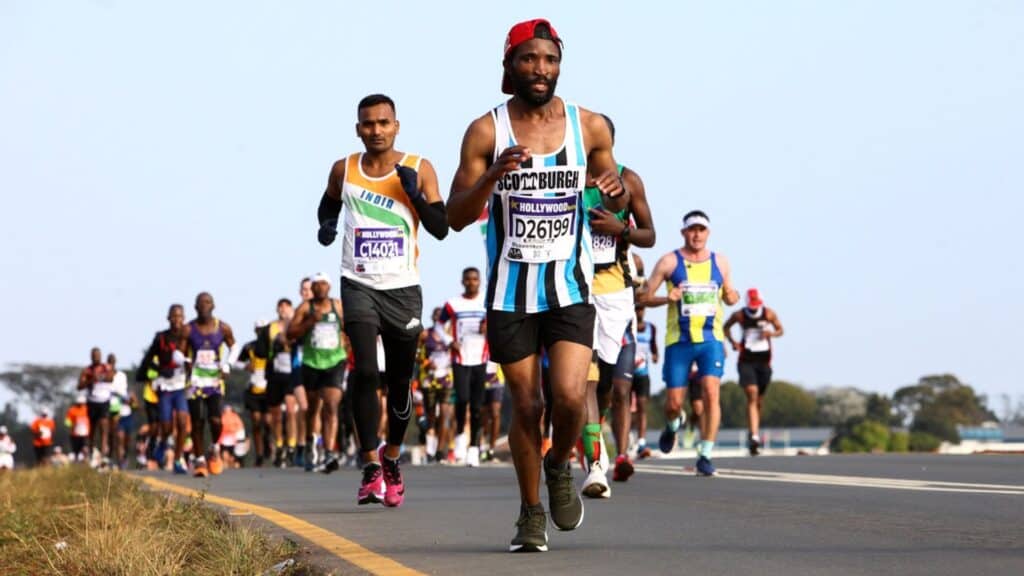
Is It Possible To Run The Comrades Marathon In 12 Months?
Going from running very little to running the Comrades Marathon in a year is a significant challenge, but it’s possible with dedication.
For those who occasionally participate in activities like Parkrun, the journey can be approached differently.
If you’ve run a Parkrun, you’re already at an advantage. For individuals engaged in regular running, approximately two to three sessions per week, all you need to do is start following our Comrades Marathon Training Roadmap.
This approach provides a good chance of qualifying and completing the Comrades marathon by the following January or February.
Even for complete couch potatoes or individuals who haven’t run in years, the dream of running Comrades is achievable within a year. While the journey can be tough, the key is to start very easily with low mileage and gradually build up the training regimen.
With determination and consistent effort, the goal of participating in the Comrades Marathon can be realized within the given timeframe.
Taking on the challenge of running the Comrades Marathon in a year involves some ups and downs. Whether you’ll succeed depends a lot on whether you already have some running ability.
For most people, it’s doable, but you have to be sensible about it because there’s a high risk of picking up injuries like shin splints and ITB, which are common when starting out too quickly.
If that sounds like you, your best shot at making it, especially in a year, is to make sure you’re in the right place, getting advice from the right people, and following a program that builds up slowly and steadily over time. Also, it’s important to start with the right gear.
This approach lowers the risk of injuries and increases the chances of reaching your goal within the given timeframe.
Setting Smaller Milestones: 5km (3.1 miles), 10km (6.2 miles), 21.1km (13.1 miles), 42.2 km (26.2 miles)
When gearing up for a big challenge like the Comrades Marathon, it’s crucial to focus on smaller milestones first. Instead of getting overwhelmed by the thought of running the full marathon, break it down into more manageable goals.
We suggest starting with shorter race distances, like 5 km (3 miles) and then gradually moving up to 10km (6.2 miles). Achieving success at each step builds both physical fitness and mental toughness.
Following a structured training plan aligned with these incremental goals is key. For example, complete a 10k training program before taking on a 21.1km (13.1 miles), and, eventually, a 42.2 km (26.2 miles) program, then lead onto a specific Comrades Marathon training plan.
This approach has several benefits. It makes the overall goal less daunting, especially for those new to running or coming back after a break. It allows you to celebrate smaller wins, boosting your confidence and motivation.
Plus, it ensures a steady and gradual increase in fitness, reducing the risk of injuries associated with sudden jumps in training intensity.
The Training Plans You Need To Go From Couch To Comrades Marathon
All of our training plans focus on not just running, but also incorporating strength training and flexibility.

This holistic approach helps prevent injuries and ensures that your body is well-rounded. The plans are designed for runners of all levels and can be tailored to your individual needs. Coach Parry’s online community is also a great resource for support and advice from fellow runners.
Completing a marathon, especially Comrades, requires more than just physical fitness. It requires mental strength, a positive mindset, and accountability. Our training plans provide all three of these elements, with built-in support and a community of runners all working towards a common goal.

Additionally, we encourage runners to focus on the process, not the outcome, and to celebrate small wins along the way. This approach helps runners stay motivated, confident, and focused, even when the going gets tough.

How Far Must You Run During Training To Complete The Comrades?
Determining the mileage needed to finish the Comrades Marathon depends on the specific training plan you’re following. The range varies based on your Comrades goal and the desired medal.
For a Vic Clapham medal or Sub 12-hour finish, the mileage typically starts around 850km or 531 miles. If you’re aiming for a Comrades gold medal, the range can extend beyond 3200km or 2000 miles.
Our Complete Comrades Marathon Mileage Guide provides a detailed breakdown of the mileage needed for each medal.
It also includes average weekly mileage, the total number of marathons and ultra-marathons in training, and the recommended length of your longest training run.
Related: Preparation & Strategies For The Comrades Marathon

About The Comrades Marathon Start Line
The Comrades Marathon is a significant event in the world of long-distance running, known for its focus on endurance and camaraderie among runners.
The race switches directions each year, either heading “up” from Durban to Pietermaritzburg or “down” from Pietermaritzburg to Durban.
If the last race started in Pietermaritzburg, chances are the next one will kick off in Durban.
As many South Africans are aware, Comrades takes place in a part of KwaZulu-Natal called the Valley of a Thousand Hills. The landscape is tough, not suited for the faint-hearted, especially during the challenging down run.
Now, let’s get a simple overview of where both the up run and down run start.
The Comrades Marathon Up Run Start Line
The Up Run of the Comrades Marathon is a tough challenge, especially in the first half, making it one of the most demanding marathons you’ll ever experience.
Unlike the Down Run, the Up Run route offers a different perspective, starting outside the old Workshop in Durban.
Getting to the start is more convenient with various transportation options and plenty of accommodation choices, some within walking distance of the starting point.
While walking to the start, especially in the dark, it’s advisable to be in the company of other Comrades runners for safety.
The atmosphere at the Durban start is lively and festive, with well-lit streets and a rock concert-like ambience. Tog bag trucks, long queues for toilets, bright lights, music, and dancing all contribute to the pre-race excitement.
You must arrive early at the start line.
This allows time for using facilities, securing your tog bag on the truck, and positioning yourself in your starting pen to maintain your seeding. Being proactive ensures a smoother start to this challenging marathon.
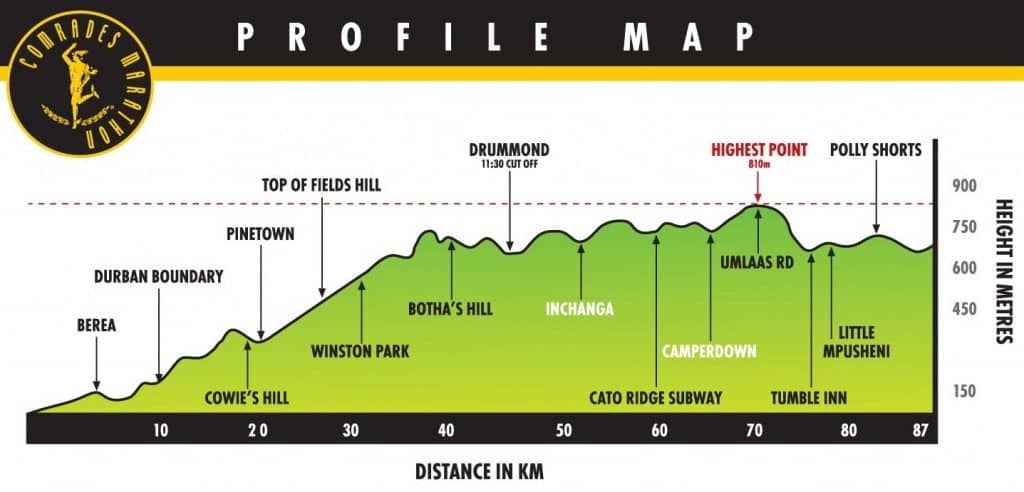
The start of the Comrades Up run in Durban is different from the one in Pietermaritzburg. The roads out of Durban are wider, allowing you to cross the line more quickly.
Additionally, Durban is warmer by several degrees.
The route profile of the Comrades Up Run appears quite challenging. You can find detailed information about the route here: The Up Run Profile, Map & Description
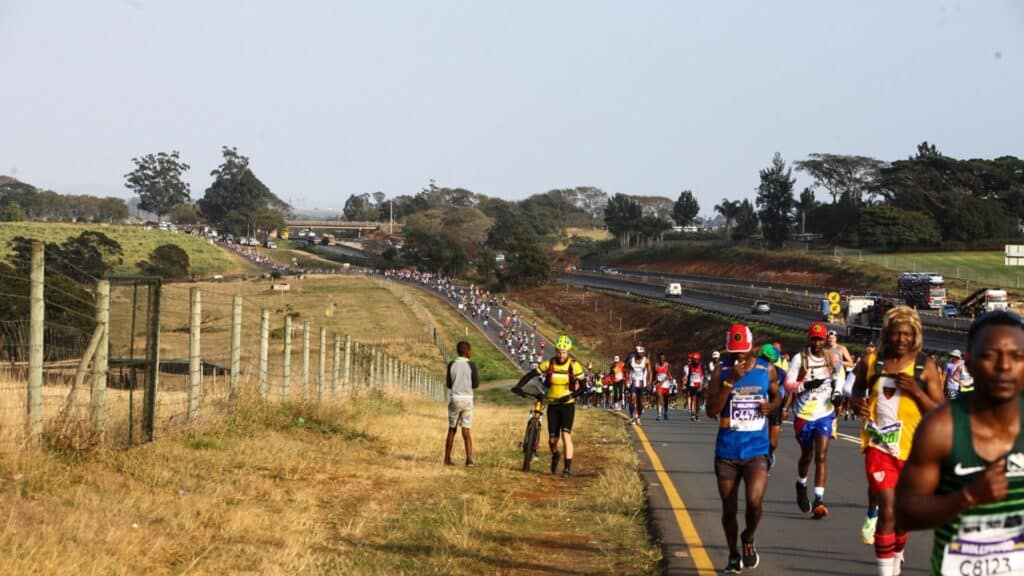
The Comrades Marathon Down Run Start Line
As with all marathons, it’s crucial to arrive early at the Down Run start line, right outside the Pietermaritzburg Hall.
Another key point to note is that, despite coming to Durban, it can be quite chilly in the morning, especially if you’re travelling from Maritzburg. The average minimum temperature around that time is approximately 4°C or 39°F.
Wearing an extra layer of clothing should be sufficient, but it’s advisable to arrive at the start area well in advance. Ensure you can drop off your belongings at the tog bag area and then proceed to your seeding pens.
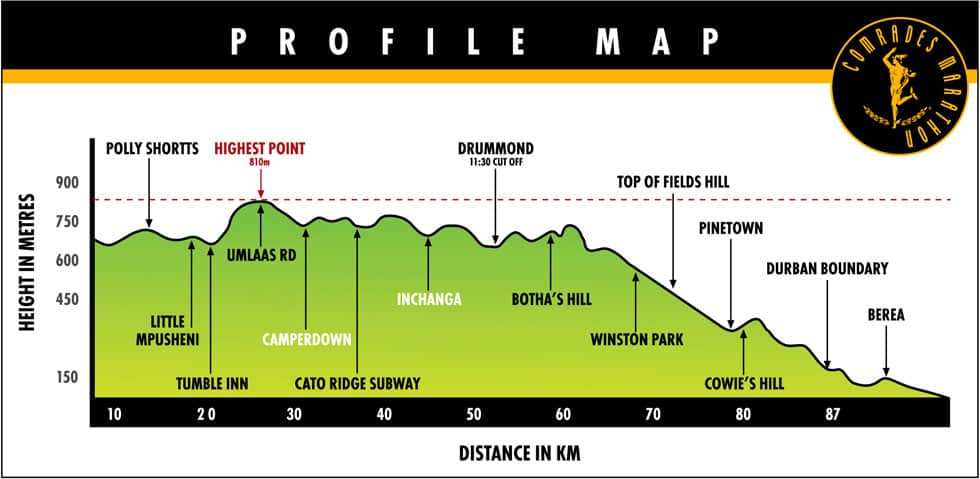
The route profile above shows a considerable amount of climbing in the first half, including the climb to the highest point on the Down run route at Umlaas Road. Much effort is needed until the climb out of Drummond on the way to Botha’s Hill.
The descent from the top of Botha’s Hill to the bottom of Fields Hill is a distinctive feature of the down run, and for many runners, it’s where challenges arise. Some runners speed down this descent to make up time, only to face difficulties in the final quarter of the race.
Conserving energy before the climb over Cowies Hill allows for making up time through Westville as you head toward the finish in Durban.
For a comprehensive and detailed description of the Comrades Marathon Down Run, including the route profile, route map, and in-depth information, this post has you covered: The Comrades Marathon Down Run Profile, Map & Description
Related: Where To Stay If You’re Running The Comrades Marathon
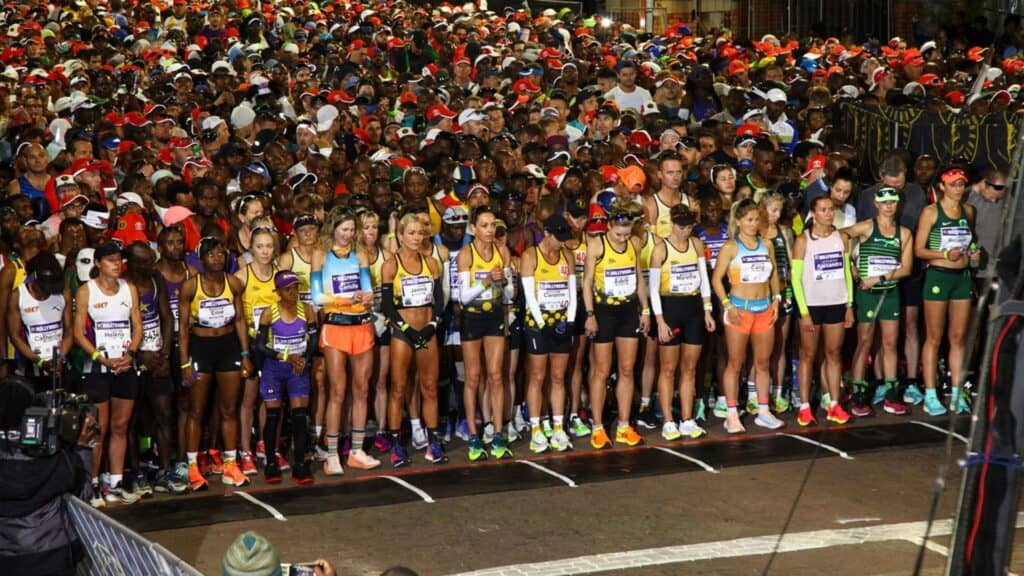
Fuel Your Body with Healthy Nutrition
Eating a healthy and balanced diet is the foundation of any training plan. You won’t be able to accomplish your goals if you don’t provide your body with enough fuel to power through your workouts.
You need to maintain a steady intake of healthy and nutritious foods for optimum performance during workouts.
To fuel your body, make sure you consume enough carbohydrates, as they serve as your body’s primary fuel during runs.
In addition to carbs, don’t overlook the importance of protein. It aids in proper recovery after intense training sessions. A helpful tip is to focus on whole, nutritious foods for the majority of your meals during marathon training.
These foods, unprocessed and rich in essential nutrients, contribute positively to your overall well-being.
A well-rounded diet should encompass various elements, including whole grains, fruits, vegetables, healthy fats, proteins, and the necessary micro and macronutrients.
Steer clear of processed foods, as they tend to be high in sugars and simple carbohydrates. These foods are easily digested, calorie-dense, and may not leave you feeling full, leading to potential overeating.
Fill your plate with a variety of fruits, veggies, whole grains, lean proteins, and healthy fats. This diverse range of foods provides the energy and nutrients required to navigate through your training successfully and emerge stronger.
Additionally, prioritize hydration throughout your training. Water plays a vital role in maintaining optimal bodily functions and performance during this marathon journey.
Related: What can I eat on Comrades Marathon race day?
Strengthen Your Body and Prevent Injury
Strength training should be an essential part of your training regimen. It helps protect you from injuries and develops overall endurance.
To strengthen your body, incorporate resistance training exercises such as squats, deadlifts, and lunges into your workouts. You don’t need a gym membership for these exercises; they can be easily done at home with a few weights and resistance bands.
At Coach Parry, we strongly believe in the advantages of strength training, which is why we’ve integrated our Strength and Conditioning (S&C) plans into our training programs.
Emphasizing proper technique is crucial, and we prioritize it in our S&C classes. It’s not just about having a plan; it’s about executing the right type of training that complements your running and doing it correctly.
Strength training isn’t solely about building muscle mass; it’s about targeting those smaller muscles that contribute to balance and joint protection.
These muscles play a vital role in maintaining proper running form and technique, reducing the risk of injury. This is particularly beneficial if you’ve dealt with injuries before and as you age.
Moreover, strength training can enhance running efficiency by 4% to 6%, allowing for smoother and less effort-intensive running. This improvement significantly contributes to overall running performance.
Making sure you do the correct strength training is important. The good news is we’ve created a free strength training plan for runners that you can download by clicking here.
Rest Day is Rest Day
Rest is just as important in your training regimen as the actual workouts. Rest days allow your body to recover, repair, and rebuild after challenging workouts. You mustn’t skip rest days thinking that it will accelerate your progress. Overtraining can harm your progress and even lead to injury or illness.
On rest days, you can still stay active by doing light exercises like walking or yoga, which can help you stretch out sore muscles. You can also use this time to focus on recovery techniques like foam rolling or getting a massage. However, make sure to give your body ample time to rest and recover between workouts to avoid injury and burnout.
Don’t Go Too Fast!
A common error for first-time marathon runners is going too fast during easy runs.
It’s crucial to remember that, especially when training on a tight schedule, speed should not be your primary concern.
Allow your body to find a pace that feels comfortable naturally. Forcing yourself to run at an uncomfortable pace increases stress, leading to longer recovery times — something you can’t afford with a limited training window.
Running at an easy, conversational pace is advisable. This conservative approach ensures you enjoy your runs, minimizes the risk of burnout, illness and injury, and prevents physical exhaustion.
Related: How To Fuel Before & During Your Long Runs
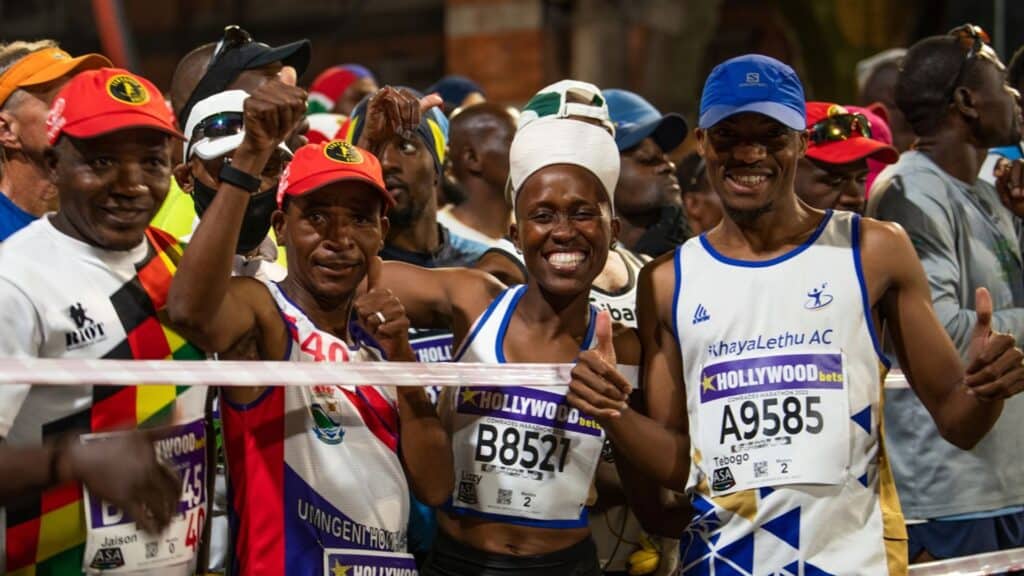
How To Stay Motivated Throughout The Entire Training
Start with baby steps
The journey to Comrades begins with taking a step forward – literally. A lot of times, many beginners tend to overcommit at the beginning, which results in burnout and loss of motivation.
Taking on too much intensity and volume too quickly puts one at risk of injuries or burnout instead of building up gradually. The first step towards success is to start with the basics and build up gradually. Set achievable goals that work for you and not against you.
Find a Support System
Training for a marathon can be incredibly overwhelming, but having a support system can make all the difference. Surround yourself with friends and family who encourage and inspire you.
Join a running group or find a training buddy who shares the same goals as you. Having someone to hold you accountable and who understands the struggles of training will keep you motivated even on the toughest days.
Set Realistic Goals
It’s essential to set goals when training for a marathon, but it’s equally important to make sure they are realistic. While it’s great to have big aspirations, setting goals that are too lofty can be discouraging when you fall short.
Break your goals down into achievable milestones, such as running a 5k or 10k. Celebrate each milestone and use that momentum to keep going.
Add Variety
Running the same route and putting in the same mileage day-in and day-out can quickly become monotonous. Keep your training fresh by mixing up your routine. Try a new running trail, add cross-training to your plan, or even switch up your music playlist.
Variety is the spice of life. The same goes for your running routine. Keep it interesting to keep yourself motivated.
Visualize Success
Visualization is a powerful tool when it comes to motivation. Take time before a training run to mentally visualize yourself hitting your goal. Use visualization not only before running but throughout the day.
Imagine yourself crossing the finish line, and let that feeling of accomplishment fuel you throughout your marathon training.
Celebrate Your Efforts
Celebrate the little successes throughout your marathon journey. Completing a long run, sticking to your nutrition plan for a week or hitting a new personal record are all achievements worth celebrating. Recognizing and celebrating these moments will keep you inspired and motivated to keep pushing yourself.
Track Your Progress
Tracking your progress is an essential part of staying motivated throughout your training. Whether you’re using a fitness tracker or a training journal, make sure you’re keeping track of your workouts, your mileage, and any improvements you make along the way.
Seeing how far you’ve come can be a great motivator, and it can help you identify areas where you need to improve.
Reconnect With Your Why
Reflect on the reasons that prompted you to start on this ultra marathon journey initially. Whether it’s for personal accomplishment, improved health, or supporting a cause you’re passionate about, reminding yourself of these motivations can serve as a strong incentive, particularly on challenging days.
Believe In Yourself, Stay Positive, and Have Fun
Training for an ultra marathon is not an easy feat, so you need to believe in yourself and your abilities. Having a positive mindset and enjoying your training journey is also important for success.
Recognize that there will be ups and downs in your training, but staying positive and having fun can make a significant difference in your overall perception.
Enjoy meeting new people, discovering new running routes, and trying out new running gear that makes you happy and more comfortable.

Invest In Good Quality Gear
Investing in good quality exercise gear that is comfortable and specific to your activity, such as supportive running shoes, moisture-wicking clothes, and compression socks, will keep you comfortable and confident during workouts.
A headband or a good sports bra can also work wonders. You may also want to mix up your gear for different workouts to keep it fun and exciting. Investing in the right gear may seem like a small factor, but it can make a big difference to your overall motivation level.
Related: Navigating Comrades Race Week: Dos and Don’ts for Success
Running The Comrades in 12 months from being a complete beginner is possible. But, it is not easy, and it requires hard work, dedication, and perseverance.
You will need to set realistic goals, gradually build up your mileage, follow a training plan, fuel your body, and stay motivated. With these elements in place, you can achieve success and accomplish what you thought was impossible.
So, if you are a beginner with dreams of running The Comrades Marathon, don’t be discouraged. Take the first step today, stick with it, and in 12 months, you could be crossing that finish line with pride.



Comments are closed.